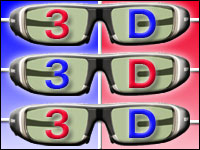
3D marketing is powerful — and even more so, when it’s delivered to the palm of your hand. Mobile 3D is becoming an increasingly common way of grabbing, holding, and entertaining consumers.
From using current mobile technologies to create a sense of 3D, to creating actual images that seem to pop off the screen and into the air, mobile marketers are using the power of interactivity to capture audiences, build brands, and sell products.
Interactivity and Immersion
Much current 3D mobile marketing takes advantage of smartphone touch technologies that let you move an object around on a screen. In this way, objects can be made to appear and feel three-dimensional.
AdJitsu, for instance, created a mobile marketing campaign in the UK earlier this year for the Samsung Galaxy, with 3D ads that were viewable without special glasses on any iOS device, such as iPhones and iPads.
The ads let consumers touch and turn a 3D image of the Galaxy this way and that to explore its various features.
“These types of ads allow you to have a choose-your-own-adventure kind of experience,” AdJitsu’s head of business development and marketing, Leslie Langan, told the E-Commerce Times. “You can interact instantaneously with it.
3D technology is especially promising in the marketing of luxury goods and 3D movies, she said.
“We’re extremely excited about the possibilities,” Langan enthused. “It’s so exciting to create an environment where the consumer can have a truly interactive experience.”
The Samsung project took the form of both a banner ad and an extendable one, meaning that from the first glimpse of the ad, a consumer could see it was something special.
It’s important to take advantage of 3D tech even in banner ads, according to Langan.
“You have to make the front door as appealing as possible,” she explained. “One of our key principles is that the consumer’s time is precious, and any ad must be as valuable as the content surrounding it.”
Interactivity is key to 3D advertising, observed Harry Dewhirst, VP of advertising at Amobee.

“Our immersive 3D ads create a fully interactive environment for the viewer through instantaneous banner expansions and fluid touch interactions,” Dewhirst told the E-Commerce Times. “The qualities of 3D advertising give the advertisement an editorial feel with rich, dynamic content so the user can browse like they would a catalogue.”
The future of 3D mobile ads looks bright, in his view, particularly as mobile devices develop more sophisticated capabilities in 3D rendering.
“As smartphones and mobile devices become more powerful, 3D mobile advertising will become pervasive,” said Dewhirst. “3D will be much more appealing than a static banner ad, and I think we will begin to see some amazing advertising.”
Taking 3D to the Next Level
To really get the sense that you’re in the middle of a 3D environment, however, you still need to wear special glasses — the kind you wear to see 3D movies. Marketers have experimented with creating glasses-required 3D ads in print magazines to good effect — for example, last October’s campaign for Honda in Maxim Magazine, designed by ad company 3DX.
“We used our patented Phantaglyph technology, and while people were flipping though the 3D pictures, suddenly a car appeared to be sitting right on top of the magazine,” explained 3DX founder Ziggy Kormandel to the E-Commerce Times. “The response to the ad was incredible, and since 3DX is the only company that can create illusions like that, it told us that we really had a hit on our hands.”
Similar 3D marketing using glasses can be done with mobile devices. The trick, however, is to make the glasses a must-have accessory.
“We’re focusing on extending the 3D experience to channels like mobile marketing, listening to what the people really want, and acting on those wishes,” said Kormandel.
“There are challenges, of course,” he continued, “including the issue of getting the glasses into the hands of the consumer. This requires creative thinking by the brands and a willingness on their part to listen to companies like 3DX. Depending on the campaign, we may recommend distributing them through a 12-pack of soda, a full-page magazine ad, a cereal box, or handed out at a live event.”
Ultimately, whether 3D mobile marketing uses current technologies or yet-to-be-developed techniques, Kormandel thinks the field is wide open for creative exploration.
“These devices hardly ever leave people’s sides, so they’re incredible devices for delivering content,” he said. “As the next round of technologies come into play — [such as] tablets with bundled 3D content like games, videos and apps; better glasses-free 3D; 3D television with enough content to make sense — I believe that good will always trump new.
“People are smart,” said Kormandel, “and something being flashy isn’t enough. Starting now and for the foreseeable future, the 3D marketers who rise to the top will be the ones who produce the highest-quality content.”






















































Social Media
See all Social Media